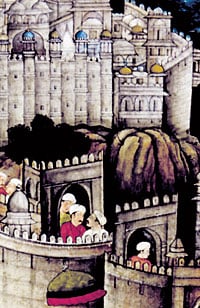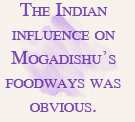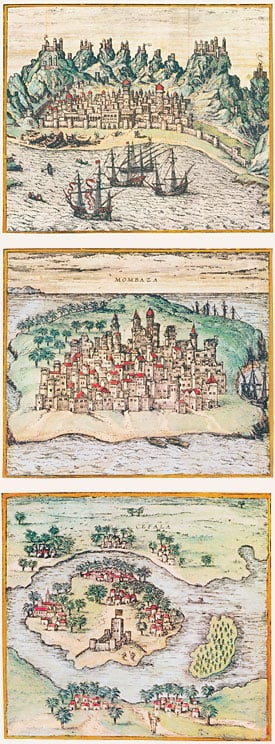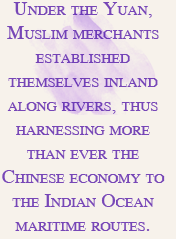
 bn Battuta first set foot in a boat in 1330. He was 27 years old and already an experienced and resourceful traveler. The boat was a jalba, one of the notorious Red Sea craft described more than a millennium earlier in The Periplus of the Erythraean Sea, made of planks sewn together with coir and waterproofed with shark oil.
bn Battuta first set foot in a boat in 1330. He was 27 years old and already an experienced and resourceful traveler. The boat was a jalba, one of the notorious Red Sea craft described more than a millennium earlier in The Periplus of the Erythraean Sea, made of planks sewn together with coir and waterproofed with shark oil.
 |
| This detail is from a 1598 painting in the manuscript of the "Baburnama," and it shows the walls of Gwalior. NATIONAL MUSEUM, DELHI / JEAN-LOUIS NOU / AKG-IMAGES |
He was in Jiddah, about to embark for Yemen and possibly one of the Gujarati ports beyond, for he had already heard that the Muslim ruler of Delhi was recruiting learned men to help with the administration of his sultanate. His companion, Mansur, urged Ibn Battuta to join him in his own jalba, but Ibn Battuta declined: “I did so because his jalba was also loaded with a number of camels, and since I had never before made a sea voyage, this terrified me.”
He was right to be worried. After two days’ sail, the wind shifted and the little fleet was driven off course. A storm rose, waves broke over the gunwales, and the passengers were seasick. The boats were finally beached not in Yemen but on the opposite shore, on the African coast between ‘Aydhab and Suakin.
The travelers hired camels and made their way south through the desert to the little island of Suakin, in the center of a deep bay surrounded by coral reefs. The ruler was Zayd ibn Abi Numayy, son of the governor of Makkah and, as it happened, brother of Ibn Battuta’s traveling companion. Their return trip across the Red Sea took six days, for although the distance is short, the lateral crossing of the Red Sea can be extremely difficult unless the winds are right.
The travelers made their way inland. Ta‘izz was the capital of Yemen and the residence of the sultan of the governing dynasty, the Rasulids, a Turkish military elite like many other dynasties of the time. Later, Ibn Battuta would find that court ceremonies here resembled those of Delhi, “but I don’t know whether the sultans of India copied the sultans of Yemen, or the sultans of Yemen copied those of India.”
Ibn Battuta next went to Aden, at the time the largest and richest of all the emporia on the Indian Ocean. “It is a big city,” he says, “but no crops, trees or water are found there; during the rainy season water is collected in reservoirs. These lie some distance from the town and the Bedouin often cut the road and prevent the townspeople from reaching them unless they are bribed with money and pieces of cloth…. It is the port for the merchants of India.” He goes on to list the Indian ports whose ships called, all on the west coast of India.
 If Aden was as rich as Ibn Battuta says, how could the inhabitants allow the Bedouin to cut them off from their water supply? Though the traveler notes this almost in passing, it tells us something about the nature of the ruling dynasties of the 14th-century world.
If Aden was as rich as Ibn Battuta says, how could the inhabitants allow the Bedouin to cut them off from their water supply? Though the traveler notes this almost in passing, it tells us something about the nature of the ruling dynasties of the 14th-century world.
Quite simply, the Rasulids of Yemen, the Mamluks of Egypt and Syria and the Delhi sultans all ruled vast dominions with too few troops. Control of their hinterlands, the spaces between major cities, was almost impossible. Even at the best of times, the ruler’s authority weakened as distance from the capital increased.
These military dynasties, whose efficacy lay in their “otherness,” had constantly to purchase new members in order to perpetuate themselves. Saladin, the founder of the Ayyubid Dynasty that ruled Egypt and Syria (and, briefly, Yemen), was a Kurd, and the sultans of Delhi and the Rasulids of Yemen were Turks, linguistically and culturally alien to the people they ruled.
The extreme example of this is the Mamluk Dynasty of Egypt, composed of Turco-Mongols and Circassians. Only slaves purchased in Central Asia or the Caucasus, usually as children, were allowed to join the ranks of the ruling caste. They were put through a rigorous course of training in the martial arts, at the completion of which they were granted their freedom.
After visiting Aden, Ibn Battuta sailed in 1331 to the East African coast, where he found another kind of state—port cities that might almost be called merchant republics. Mogadishu, now in Somalia, was the first he visited: “Mogadishu is a very large town. The people are merchants and very rich. They own large herds of camels…and also sheep. Here they manufacture the textiles called after the name of the town; these are of superior quality and are exported to Egypt and other places.”
Cultural Markers
The custom of chewing betel leaves with prepared lime and areca nuts defines a huge cultural area extending from India through Southeast Asia, East Africa and parts of Arabia, cutting across religious and political boundaries. The ceremonial offering of betel, called sirih in Malaya and Indonesia, is an essential cultural trait. As Ibn Battuta says, “The offering of betel is much more important and shows more honor to the recipient than would the gift of silver or gold. Before eating the leaves, one takes areca nut, which is like nutmeg but broken up into little pieces, and chews them. Then you take the betel leaf with a little lime on it and chew it along with the areca. The leaves make the breath sweet and the mouth fresh. They aid the digestion and alleviate the effects of drinking water on an empty stomach.” Another defining custom of the monsoon cultural area was the custom of wearing a ceremonial dagger—the kris of Malaya and Indonesia and the jambiyyah of Arabia. Nor was cultural interchange in the region limited to dress and food: Ibn Mujawir, writing in the 13th century, locates an episode from the Hindu epic, the Mahabharata—the burning of Lanka by the monkey warrior Hanuman—in Aden, rather than Sri Lanka. |
As soon as he was settled in Mogadishu, the sultan sent him two small welcoming gifts: a plate of betel leaves and areca nuts, and a vial of Damascus rosewater. The first was the ritual welcoming gift of India, a custom that had spread to East Africa, and the rosewater from Damascus was to rinse his hands—another indication of far-flung commercial contact. The ceremonial meal that followed makes a similar, if more elaborate, point:
They eat rice cooked with ghee, which is served on a large wooden platter. On top they set dishes of kushan. These are relishes, composed of chicken, meat, fish and vegetables. In one dish they serve green bananas in fresh milk, in another yogurt with pickled lemon, bunches of pepper pickled in vinegar and salt, green ginger and mangoes. These are like apples, but with a pit. They are very sweet when ripe, but when immature are acid like lemons; they pickle the unripe mangoes in vinegar. They eat a mouthful of rice, then some of the salted and pickled relishes.
The Indian influence on this meal is obvious, but it has been adapted to local tastes. The rice and pepper would have been imported, but the mangoes were probably now grown locally, as was another Indian fruit, the jammun or jambul (Eugenia jambolana, java plum), which he encountered in Mombasa. Bananas also came to East Africa from India, perhaps as early as the 10th century. Although Ibn Battuta does not mention it, the meal was almost certainly served in Chinese bowls, much prized all along the East African coast. Special niches were built into the walls of dwellings in order to display the finer pieces.
After Mogadishu, Ibn Battuta sailed further south to Mombasa and Kilwa, both important trading cities. The wealth of these cities was later to strike the Portuguese, for it was based on the export not only of gold, but also of iron, which was sent to India, worked into steel, then re-exported to the Middle East. Ivory and tortoise-shell were other valuable exports. From Kilwa Ibn Battuta sailed to Dhufar, on the coast of the Arabian Peninsula, now in Oman. This was the Incense Coast of classical times. Millet and barley, he reports, were grown near the town, irrigated from deep wells, and rice was imported from India.
The people of Dhufar are traders and have no other means of livelihood. When a ship arrives from India, the sultan’s slaves go out to meet it in little boats, taking a full set of robes for the owner and captain, as well as for the kirani, the ship’s accountant…. Everyone on board is granted hospitality for three days; when the three days are up, they are fed in the sultan’s residence. The people do this in order to win the friendship of the ship-owners. They wear cotton clothes imported from India, fastening a length of cloth around their waist in place of trousers….They manufacture silk, cotton and linen cloth of excellent quality.
The fact that a local manufacturing industry was based on imported raw materials shows how regular shipping must have been, and how Indian Ocean traffic was not just in high-value, low-bulk items like spices. Textiles were always the bread and butter of the Indian Ocean trade, their production involving many ancillary techniques and employing thousands.
Bananas and betel, both of Indian origin, were cultivated in irrigated plantations on the outskirts of Dhufar. Since remote antiquity, southern Arabia, with its maritime links to India and Ethiopia, had been the corridor for plant introductions from both East and West. Durum wheat, sorghum, cotton, sugarcane, taro, indigo, oranges, lemons and many other plants had traveled this way. Some, like wheat and sorghum, returned from India in improved varieties and were then widely diffused in Africa and Europe.
 |
| From top: From Aden, at the farthest western reach of the Indian Ocean and one of the richest emporia of its time, Ibn Battuta sailed down the east coast of Africa. Among his ports of call was Mombasa (center), known for exports of gold and iron. He traveled as far south as Kilwa, still well north of Sofala, the most distant Arab port on the coast (lower). The progression from Aden’s cosmopolitan bustle to Sofala’s isolation is easily seen in these colored engravings from the late 16th century. BRAUN AND HOGENBERG, CIVITATES ORBIS TERRARUM, 1572 (3) |
After visiting Oman, Ibn Battuta sailed across the Gulf to Hormuz. Until 1300, Hormuz had been located on the mainland. But in that year the ruler moved to the island of Jarun for greater security. “New Hormuz” was appallingly hot and dependent on the mainland for food, fuel and water, but it was strategically placed, controlling both sides of the Gulf at its narrowest point. It was “a big handsome city with excellent markets, for it is the port of India and Sind. Indian goods are exported from here to the two Iraqs, Fars and Khurasan.” Later, Hormuz would grow to rival Aden as the western hub of Indian Ocean commerce, replacing earlier Gulf emporia like Siraf, Kish and Suhar.
On September 12, 1333, after a two-year detour through Iran, Anatolia and Central Asia, Ibn Battuta finally stood on the banks of the Indus River, the western border of the domain of Muhammad Shah II, Sultan of Delhi.
To discourage casual visitors, each person wanting to enter India had to sign a statement in front of a notary swearing that he would remain forever. He also had to bring a substantial gift for the sultan—there were agents at the border who would advance money to travelers for this purpose—in order to demonstrate the seriousness of the immigrant’s intentions; when he presented his gifts in Delhi, the newcomer would receive many times their value in reciprocal gifts from the sultan. This exchange cemented a bond with tacitly understood mutual obligations.
Ibn Battuta was advanced money by an Iraqi merchant from Tikrit and bought 30 horses and a camel-load of arrows. These were acceptable gifts for a ruler engaged in enlarging his domains, and Ibn Battuta’s prudent investment was rewarded with the post of chief jurist (qadi) of Delhi at an annual salary of 12,000 dirhams—the revenues of two villages—and a lump-sum sweetener of 12,000 dinars. Overnight, the obscure Moroccan law student became a rich man.
Two years later, famine broke out in the sultan’s territories and lasted for seven years, leading to widespread rebellion. Ibn Battuta saw that the Delhi sultanate was unraveling and applied for permission to make the pilgrimage to Makkah, the only politic way of leaving the sultan’s service. At the last minute, the sultan asked him instead to lead 15 Chinese envoys and several shiploads of gifts to the Mongol Yuan emperor Toghon Temur. Ibn Battuta leapt at the chance for a graceful exit from a difficult situation combined with the opportunity to visit a new country.
The official delegation set out in the late summer of 1341 for the port of Cambay. It was attacked on the way by Hindu marauders, showing Muhammad Shah’s tenous hold on the countryside. Ibn Battuta was captured, escaped and rejoined his party. In Cambay he found a port whose wealth was based on the export of the finest cotton textiles in India, produced in the villages of Gujarat.
The mission met the sea captain and shipowner Ibrahim, who owned six ships. They must have been large, for into one of them, the Jakar, they loaded 70 horses, gifts for the Chinese emperor. They loaded 30 other horses, together with their own mounts, into the Manurt. Ibn Battuta embarked in the Jakar, along with 50 bowmen and 50 Abyssinian warriors: “They are the lords of this sea, for even if there is only one of them in a ship, pirates and Hindus think twice about attacking.”
As they sailed down the west coast of India, Ibn Battuta counted 12 semi-autonomous states, each of which owed its existence to the Indian Ocean trade. Whether the rulers were Muslim or Hindu, commerce was largely in the hands of Muslim merchants of the most varied origins. The rajas of these little states collected a percentage from every transaction and in return allowed the merchant communities freedom of worship.
 |
| How far into China Ibn Battuta traveled during his few months there is debatable. He claimed he reached Beijing, but his description of it is uncharacteristically thin. This painting from the early 15th century shows the houses of Kinsai, China, with characteristically curved roofs and bridges over canals. BIBLIOTHEQUE NATIONALE / ARCHIVES CHARMET / BRIDGEMAN ART LIBRARY (BOUCICAUT MASTER) |
The richest towns of all were along the Malabar coast, the main source of the pepper that commanded such high prices in the markets of China, Alexandria and Venice but also of the teak used for building ships. The romance of the spice trade often obscures the fact that the bulk of Indian Ocean shipping was devoted to cargoes like rice, hardwoods, tin, iron ore, horses, weapons, textiles and other essential commodities.
When the little fleet reached Calicut, there were 13 junks anchored in the harbor, into which their cargo was transferred for the voyage to China. Their construction fascinated Ibn Battuta, who was especially struck by the self-contained compartments into which the hull was divided to minimize the danger of sinking. The junks had large cabins in which a number of people could travel in comfort, with private bathrooms and even stewards. A large junk could carry a crew of 1000, he wrote. This seems incredible, and scholars hotly debate the question of the size of medieval junks.
That night, a storm arose. Two large junks into which everything had been loaded put to sea, only to run aground and be smashed to pieces. Most of the passengers drowned, and the gifts for the Chinese emperor sank to the bottom.
Ibn Battuta escaped, for he had gone ashore to attend Friday prayers in the mosque. A small junk, called a kakam, with his wife aboard, also put to sea. With no possessions but his prayer rug and 10 dinars, Ibn Battuta set off on foot for Quilon, 300 kilometers (180 mi) down the coast, where he was told her ship was bound. There, he found no sign of the kakam. He later learned it had been captured by ships from Sumatra and that his wife was dead and all his possessions lost. Ibn Battuta nevertheless decided to continue to China on his own. After multiple stops and multiple mishaps, he reached Sonargaon, in today’s Bangladesh, where he bought passage on a junk for Sumatra.
Samudra, the port on the northern coast of Sumatra that has lent the island its name, was the first outpost of Islam in the huge Hindu–Buddhist area of what is now the Indonesian archipelago; it was the model for the Malay-speaking Muslim principalities which, over the next 300 years, were to spring up there.
 The ruler of Samudra, Al-Malik al-Zahir, sent Ibn Battuta on to Guangzhou, the city Marco Polo called Zaitun, in a junk outfitted at his own expense. He set sail in April 1346 as soon as the southwest monsoon began to blow.
The ruler of Samudra, Al-Malik al-Zahir, sent Ibn Battuta on to Guangzhou, the city Marco Polo called Zaitun, in a junk outfitted at his own expense. He set sail in April 1346 as soon as the southwest monsoon began to blow.
China at the time was ruled by the Mongol Yuan Dynasty, whose most famous ruler had been Kubilai Khan, who ruled during the years Marco Polo traveled in China. Although not Muslim, the Yuan relied heavily on Muslim officials and military advisors and encouraged Muslim trade. It was under the Yuan that Muslim merchants established themselves at key nodes along the rivers and canals of the empire. This harnessing of the hugely productive Chinese economy to the overseas maritime routes stimulated the growth of the new Muslim principalities in the Indonesian archipelago and the establishment there of Chinese merchant communities. Malaya and Indonesia became the turntable through which Chinese manufactures were distributed to the West.
Though Ibn Battuta was impressed with China, particularly with paper money and the quality of Chinese silks and porcelain, it was the only country he ever visited that affected him with culture shock. “Every time I left my house, I saw reprehensible things. I was so disturbed that I stayed home most of the time, only going out when necessary.” Yet at the same time, he opined, “China is the safest and pleasantest country in the world for the traveler.”
His account of travels within China lacks the characteristic detail that makes the rest of Ibn Battuta’s travels so entertaining, and his trips to Hang-chou and what is now Beijing are so vaguely described as to raise the suspicion that they are invented. His stay was brief, and by December 1346 he was back in Quilon, en route to his native Morocco.
 |
Historian and Arabist Paul Lunde studied at London University’s School of Oriental and African Studies and specializes in Islamic history and literature. He is the author of Islam: Culture, Faith and History. With Caroline Stone, he has translated Mas‘udi’s Meadows of Gold and—forthcoming this fall from Penguin—Travellers From the Arab World to the Lands of the North, a collection of travel accounts. Lunde is a longtime contributor to this magazine, with some 60 articles to his credit over the past 33 years, including special multi-article sections on Arabic-language printing and the history of the Silk Roads, and the theme issue “The Middle East and the Age of Discovery” (M/J 92). He lives in Seville and Cambridge, England, and is working on an Internet project to map pre-modern Eurasian cultural and intellectual exchanges. He can be reached at paullunde@hotmail.com. |
< Previous Story | Next Story >





